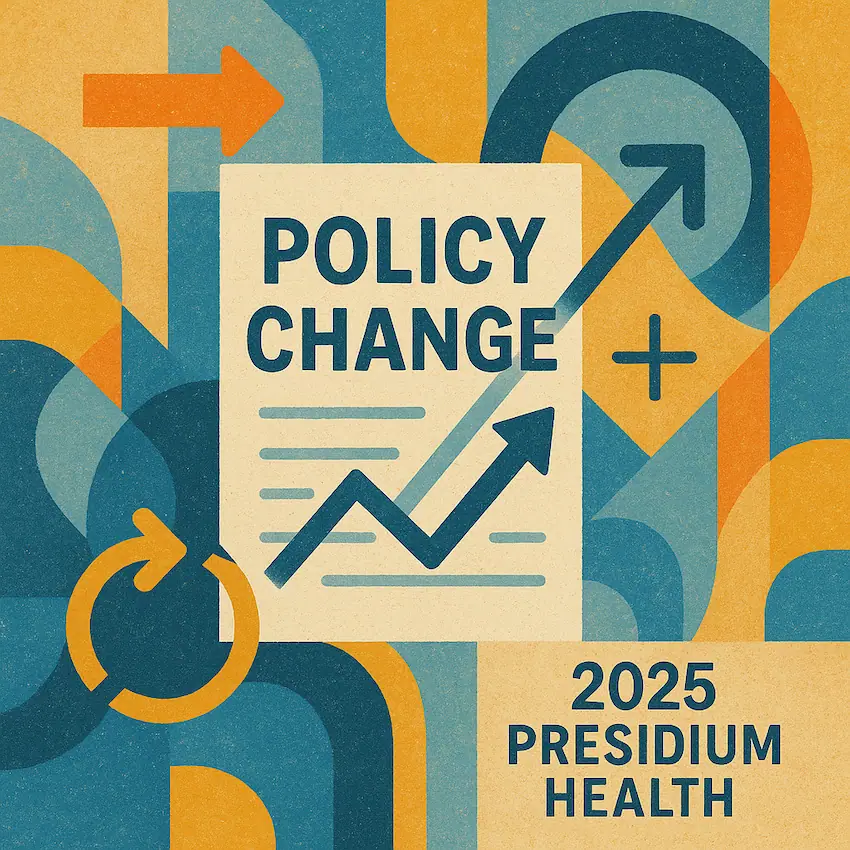
Transitional Care Management (TCM) Policy Guide
Transitional Care Management (TCM) has become a cornerstone of modern health care policy, bridging the critical gap between hospital discharge and community-based follow-up care. Since its creation, transitional care management services have represented both a policy innovation and a reimbursement strategy designed to improve patient outcomes, reduce readmissions, and align payment with value-based care. Over the last decade, TCM services have grown from an underutilized billing option to a policy centerpiece that reflects the industry’s emphasis on coordinated, equitable, and efficient care delivery. Learn more about how transitional care services support patients as they move between care settings.
Historical Background of Transitional Care Management
Transitional Care Management emerged in the early 2010s against the backdrop of rising concern about hospital readmissions. At the time, nearly 1 in 5 Medicare beneficiaries were readmitted within 30 days of discharge, costing the system an estimated $17 billion annually in preventable spending. Readmissions were not only costly but also disruptive to patient health, signaling significant gaps in care continuity after hospital discharge from an acute care hospital or skilled nursing facility.
In 2012, CMS implemented the Hospital Readmissions Reduction Program (HRRP) under the Affordable Care Act, which penalized hospitals with excess readmission rates for conditions such as heart failure, pneumonia, and myocardial infarction. This policy shift underscored the financial and clinical urgency of improving post-discharge outcomes and created strong incentives for providers to invest in coordination of care.
In response, in 2013 CMS introduced TCM codes 99495 and 99496 in 2013, formally reimbursing transitional care services. This was a watershed moment: Medicare was now paying for coordination of services itself, not just episodic visits. The goal was clear: incentivize physicians and non-physician practitioners such as primary care physicians, nurse practitioners, and clinical nurse specialists to conduct timely outreach, medication reconciliation, and structured follow-up visits, ultimately aiming to reduce avoidable readmissions and aligning provider reimbursement with improved patient outcomes.
Evolution of Transitional Care Management (TCM): A Decade in Motion
From Pilot to Mainstream
Initially underutilized due to complex documentation requirements, TCM has steadily grown into a mainstream tool for chronic care and broader care management services.
Integration with Value-Based Care
As Accountable Care Organizations (ACOs) and bundled payments gained traction, TCM proved a natural fit, supporting federal and payer incentives through Medicare & Medicaid services to reduce costly hospital utilization.
Expanded Care-Team Roles
CMS clarified that non-face-to-face services could be performed by clinical staff under general supervision, enabling primary care providers, case managers, and community health workers to participate in transitional care.
Complementary Codes Expand the Ecosystem
Over time, CMS expanded the care-management suite with Chronic Care Management (CCM), Principal Care Management (PCM), Remote Patient Monitoring (RPM), and most recently Community Health Integration (CHI) and Principal Illness Navigation (PIN), allowing TCM to act as the entry point for ongoing, longitudinal care.
How Does Policy Shape Transitional Care Management?
Financial Incentives To Reduce Readmissions. HRRP penalties tied transitional care to hospital bottom lines, ensuring that reducing readmissions became both a clinical and financial imperative.
Creation of Dedicated Billing Pathways. The establishment of TCM CPT billing codes legitimized care coordination as reimbursable, creating a payment mechanism to support structured follow-up.
Expansion to Address SDOH. By introducing codes for SDOH assessment and CHI, policy now acknowledges that transitions are unsafe if patients lack food, housing, or transportation. See how addressing housing, food, and transportation barriers improves TCM outcomes.
Integration Into Value-based Models. Transitional care has become embedded in ACO metrics, bundled payments, and state Medicaid services waivers like CalAIM ECM.
Ongoing Evolution. With APCM now blending TCM, CCM, and PCM, policy signals that transitional care should be part of continuous longitudinal engagement, especially after a new diagnosis or worsening medical condition.
Policy Impacts On Providers Delivering Transitional Care
Compliance & Documentation
Track outreach, required face visits, and med rec to secure reimbursement.
Financial Risk & Opportunity
Medicare adjustments affect TCM revenue; HRRP penalties pressure acute facilities.
Operational Adaptation
Delegation pushes role redesign, leaning on nurses & outpatient providers.
Payer Contract Alignment
MA & Medicaid managed care tie payment to transitional care metrics.
Value-Based Positioning
Robust TCM supports ACOs, bundles, and risk—cutting costs & boosting satisfaction.
The TCM Billing Snapshot (What Hasn’t Changed)
30-Day Episode
Begins on discharge and extends for 29 additional days.
Core Components
- Initial Contact: within 2 business days of discharge.
- Required Face-to-Face Visit:
- Within 14 days for CPT 99495 (moderate MDM)
- Within 7 days for CPT 99496 (high MDM)
- Medication Reconciliation: by or on the visit date.
Billing Rules
- Only one practitioner may bill per episode.
- The face-to-face visit is bundled into TCM (not separately reimbursable).
- TCM is not payable if overlapping with a post-op global period for the same provider.
Eligible Providers
Physicians, Nurse Practitioners (NP), Physician Assistants (PA), Clinical Nurse Specialists (CNS), and Certified Nurse Midwives (CNM).
Note: Non-face-to-face elements may be delegated to qualified clinical staff.
Current Policy Updates Elevating TCM
Medicare Payment Trends (2025)
Lower Conversion Factor. For calendar year CY 2025, the Physician Fee Schedule (PFS) conversion factor is set at $32.35, representing a −2.93% reduction from 2024. This decline directly reduces the dollar amounts reimbursed for Transitional Care Management (TCM) as well as a wide range of other physician services. While the percentage reduction may appear modest, its cumulative impact is significant, especially for practices that depend heavily on Medicare reimbursement. For example, even small shifts in the conversion factor can create substantial financial strain when multiplied across high volumes of TCM, chronic care, and evaluation and management (E/M) services. Practices must account for this decrease in revenue by optimizing service capture, reducing leakage, and layering reimbursable care management activities to sustain margins.
Advanced Primary Care Management (APCM). To balance reimbursement pressures, CMS has finalized the Advanced Primary Care Management (APCM) codes (G0556–G0558), creating a monthly bundled payment structure. This bundle incorporates critical elements of Transitional Care Management (TCM), Chronic Care Management (CCM), and Principal Care Management (PCM), signaling a major policy shift toward continuous, longitudinal coordination of care rather than episodic or event-based billing. APCM is designed to reward practices that manage patient complexity proactively across transitions of care, chronic disease management, and preventive services. In practice, this means that providers who establish robust, multidisciplinary care teams—including physicians, nurse practitioners, clinical nurse specialists, and community health workers—will be better positioned to capture APCM reimbursement. The codes reflect CMS’s broader goal of aligning payment incentives with value-based care, where care continuity, reduced readmissions, and improved patient outcomes take precedence over one-time encounters.
Stable Policy Framework. Despite ongoing fluctuations in reimbursement amounts, CMS continues to double down on Transitional Care Management (TCM) as a high-value service within the Medicare program. Since its introduction in 2013, TCM has evolved from a niche billing option into a policy cornerstone that bridges acute care discharge and long-term outpatient management. The persistence of TCM within the PFS—even amid conversion factor cuts—demonstrates CMS’s recognition of its role in reducing readmissions, supporting smoother handoffs, and ensuring patient safety during vulnerable transition periods. The consistency of this framework offers stability for practices: while payment rates may contract, the clinical and policy validation of TCM remains strong, and its integration into newer models like APCM confirms that transitional care is no longer a standalone concept, but a foundational pillar of longitudinal care management.
The Next Iteration: APCM
CMS introduced Advanced Primary Care Management (APCM) to streamline and strengthen how Medicare supports comprehensive, ongoing primary care. Traditional care management programs like TCM, CCM, and PCM had strict time-tracking and fragmented billing rules, creating administrative burden and limiting uptake. APCM replaces those with a simplified monthly bundled payment that covers transitional care, chronic disease management, and coordination services, while also tying reimbursement to quality reporting and performance measures. By doing this, CMS is testing whether a more flexible, longitudinal model can reduce paperwork, encourage provider participation, improve care coordination, and advance equity—especially for high-risk and low-income populations. Ultimately, APCM is designed to push the system further toward value-based care, ensuring that primary care teams are incentivized to focus on outcomes, patient engagement, and population health management rather than isolated, time-limited services.
The launch of Advanced Primary Care Management (APCM) represents one of CMS’s boldest steps toward reshaping how primary care is delivered and reimbursed. On paper, APCM offers exactly what providers have long asked for: simplified billing, a broader scope of covered services, and a stronger push toward value-based care. But while the promise is clear, the proof is not—at least not yet. The question now is whether this model will truly reduce administrative burden, support equity, and drive better outcomes—or whether it will fall short of its ambitious goals. For now, APCM is best seen as an experiment in progress, and only time will tell if it can deliver on its potential to transform primary care.
Add-On Services (2024–2025)
SDOH Risk Assessment (G0136)—structured screening for social risk factors. By standardizing and reimbursing social risk screening, providers can proactively identify barriers that might derail a safe recovery after discharge.
Community Health Integration (CHI)—community health worker services addressing barriers to care. CHWs often act as trusted, culturally aligned liaisons between the healthcare system and patients, addressing barriers that clinical teams may not have the bandwidth or expertise to manage.
Principal Illness Navigation (PIN)—navigator/peer-support or non-clinical staff for patients with complex conditions. PIN provides a central point of contact and coordination.
Caregiver Training (96202–96203, 97550–97552)—structured education to improve safety at home. Discharge is often unsafe when caregivers are unprepared. Inadequate caregiver support is one of the top drivers of readmissions and emergency visits. By funding caregiver training, these codes shift the paradigm from “discharge and delegate” to “equip and empower.”
Medicaid & Medicare Advantage Trends
Within Medicaid, many states reimburse TCM, but some—including California through CalAIM—cover transitional care under Enhanced Care Management (ECM) as a per-member-per-month (PMPM) benefit. Discover how enhanced care management extends transitional care for complex patients. These contracts typically require structured outreach, admission/discharge tracking, observation discharge services, medication reconciliation, and warm handoffs to community resources. Whereas most Medicare Advantage plans align with Medicare policy but may impose prior authorization, stricter documentation, or concurrency restrictions.
Strategic Implications for Providers
Prepare For Reimbursement Pressure. The CY 2025 Physician Fee Schedule (PFS) conversion factor is dropping, creating immediate financial headwinds. Counter this by layering reimbursable services and enrolling eligible patients into Advanced Primary Care Management (APCM) to stabilize revenue streams.
Build A Pipeline For Long-term Engagement. Use Transitional Care Management (TCM) as the entry point for extended care models. Create seamless pathways into Chronic Care Management (CCM) and Principal Care Management (PCM), and link patients to the annual wellness visit to strengthen preventive care and continuity.
Address SDOH Systematically. Integrate structured social determinants of health (SDOH) screenings into transitions of care. By identifying and addressing social needs early, practices improve patient compliance, reduce readmission risk, and capture opportunities for better care outcomes.
Align With Payer Expectations. Stay ahead of contract performance requirements by tracking quality measures, compliance rules, and alignment objectives closely. Meeting payer expectations ensures both revenue protection and long-term partnership stability.
Invest In Infrastructure. Equip your teams with the right tools—EHR alerts, ADT feeds, discharge registries, and communication platforms—to streamline outreach, support comprehensive care plans, and ensure timely follow-up. These investments reduce staff burden while scaling transitional care services effectively.
Why Transitions Matters More Than Ever
Health Equity. When Transitional Care Management (TCM) is paired with social determinants of health (SDOH) screening, it becomes more than a billing code—it becomes a powerful equity tool. Identifying and addressing barriers like food insecurity, transportation gaps, or housing instability ensures that patients receive care tailored to their real-life circumstances. This connection elevates transitional care into a driver of fairness, access, and healthier communities.
Continuity of Care. At its core, TCM is the bridge—reducing fragmentation and ensuring that no patient is left behind after a medical crisis. By guiding individuals safely from hospital to home, TCM prevents patients from “falling through the cracks” and instead creates a seamless journey of support. This continuity not only strengthens outcomes but also reinforces the promise that healthcare can be reliable, compassionate, and patient-centered at every step.
Presidium’s Approach To Navigating Policy Change
Success Leaders in Transitional Care Management Services
Presidium’s transitional care management value pyramid reflects how the operational foundation supports integrative practice- culminates in payer alignment and health equity.
Strategic Impact: Payer Alignment & Health Equity
Aligns with value-based models and eliminates non-clinical barriers to improve outcomes and satisfaction.
Workflows mapped to Medicaid (e.g., CalAIM ECM) and Medicare, optimizing performance where smooth transitions reduce costs.
Community navigation, caregiver education, and patient-centered engagement address SDOH to ensure equitable, durable outcomes.
Integrative Practices: Stacking Services & Policy Vigilance
Extends support beyond the 30-day window and keeps pace with CMS/Medicaid policy changes.
Integrates concepts from TCM with CCM, PCM, and structured SDOH assessments to create a continuous, comprehensive care plan.
Monitors CMS rulemaking and Medicaid innovations; rapidly updates billing codes, concurrency rules, and documentation standards.
Operational Foundation: Compliance & Multidisciplinary Teams
Automated compliance and team-based coverage enable reliable execution across care transitions.
EMR alerts and workflow automation support 2-day outreach, required face-to-face visits, medication reconciliation, and observation discharge services.
Primary care physicians, nurse practitioners, clinical nurse specialists, case managers, support specialists, and CHWs coordinate across acute discharges and SNF transitions.
The Result. Through this structured and adaptive approach, Presidium ensures that transitional care is not just a compliance or coding exercise, but a high-value service that improves patient outcomes, strengthens provider-payer relationships, and safeguards financial sustainability in a shifting regulatory environment.
Conclusion
Since its inception in 2013, Transitional Care Management has evolved from a narrow billing innovation into a policy anchor for reducing readmissions, improving outcomes, and advancing equity. Its origins lie in tackling pervasive hospital readmissions and aligning provider incentives with patient well-being. Today, TCM sits at the intersection of federal payment reform, state Medicaid services innovation, and care-delivery redesign.
Policymakers and health plans increasingly expect providers to demonstrate value, which makes transitional care success metrics a critical component of aligning with policy and reimbursement requirements. Providers that embed TCM into their workflows—and connect it to complementary codes, longitudinal care plans, and SDOH strategies—will not only strengthen patient outcomes but also position themselves for success in the era of value-based care.
Presidium’s experience demonstrates how this can be achieved in practice: by staying ahead of policy shifts, aligning with payer requirements, and delivering seamless coordination of services, Presidium shows that transitional care management services can be both sustainable and transformative.



